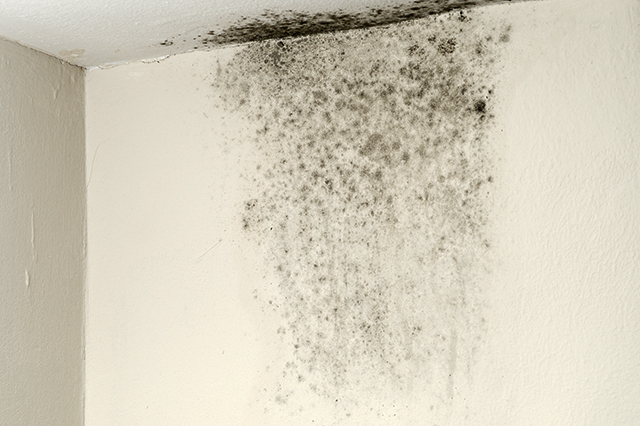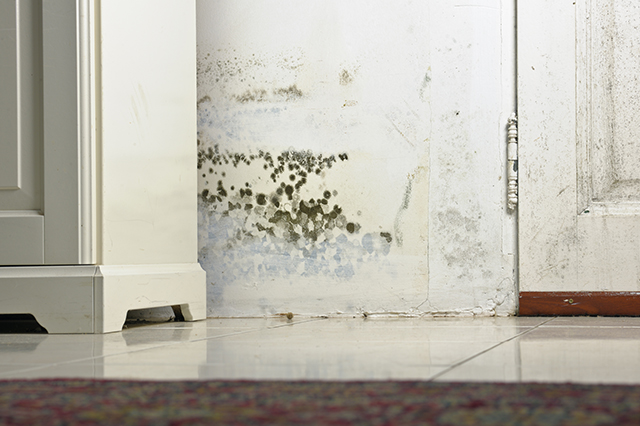Mold is very tricky. Sometimes you don’t notice it at first. Sometimes it festers in corners or behind wallpaper. Sometimes it can even make you sick. But does home insurance cover mold? Rather, does it cover mold removal? Because when you find mold in your house, the very first thing you want to do is get rid of it. Your home is likely your largest investment, and severe mold damage can harm the resale value.
What Does Mold Do?
Four of the most common indoor molds are Cladosporium, Penicillium, Alternaria and Aspergillus. Cladosporium may cause ear or eye infection, and it can also affect those with allergies, asthma or other respiratory conditions. Penicillium did, in fact, lead to the discovery of penicillin, and most strains are not very harmful to humans. Alternaria and Aspergillus can cause allergies and inflame skin and mucous membranes – they’re also especially harmful for people who are immunocompromised.
No matter what mold you have, it’s likely bothersome to those with asthma and it might make you feel like you have a perpetual cold. There are of course other molds, like black mold, that can be much more harmful. So whenever you spot mold, take action quickly.
Does Home Insurance Cover Mold?
“The answer is generally no,” said Patrick Sullivan, director of insurance sales at AAA Northeast, “unless it is the result of what we call a covered peril.”
For most homeowners insurance policies, financial protection is only given for damages stemming from sudden and accidental causes. These commonly include:
- Fire.
- Smoke.
- Car or aircraft collision.
- Strong winds or windstorms.
- Hail.
- Sudden and internal water damage.
- Roof collapse.
- Lightning strikes.
- Theft.
- Explosion.
These are all occurrences that happen suddenly and generally could not be prevented. There is a clear cause-and-effect relationship between the incident and the damages it may have caused.
Mold doesn’t act like this. No one is suddenly struck by mold – even if it’s been growing in secret. Even if there’s no way you could have known about it. Mold growth is gradual, so it’s usually challenging to prove what exactly the cause was, or when the trouble began.
Homeowners insurance doesn’t usually cover nuisances like bedbugs, termites or mold. Like mold, bug infestations occur over time, and it’s often difficult to tell the difference between bad luck and neglect on the homeowner’s part. Therefore, they are considered maintenance issues.
There are, however, certain very specific circumstances under which mold might be covered.

What’s Covered
“For instance,” Sullivan said, “If ice damming occurs to your roof and it results in water damage to the inside of your home, and that leads to mold, then you should be covered. However, if you discover mold in your home resulting from a maintenance issue, or if the mold was there prior to you purchasing the home, then it would not be covered.”
Or, let’s say there was a fire in your home. Fortunately, most of your home is still intact since the firefighters arrived quickly and put it out. However, due to the water from the fire hoses, your home has developed mold. That could be covered by home insurance.
As long as the mold is caused by an event that is listed on your policy, your home insurance may cover its removal. If mold is caused by gradual seepage, neglect or general humidity, it usually is not covered.
“Some carriers may provide an endorsement to cover mold,” Sullivan said. “If someone is interested in that, they should consult with their insurance agent.”
Home insurance does not cover flooding, but if you live in an area that floods regularly, you might already have flood insurance. Flood insurance will most likely cover any sudden mold damage caused by a flood.
How to Control Mold
Although mold is sometimes the result of circumstances beyond your control, sometimes mold growth can be prevented.
Mold flourishes in dark, wet and warm environments. The damp areas of your house, like the bathroom, kitchen or laundry room, are the most susceptible to mold. To avoid mold growth, try to keep the humidity in your home to a minimum.
Ventilation is also important – make sure you have an exhaust vent in your bathroom and your kitchen. If you have a clothes dryer, make sure that it vents to the outside of the house.
If you discover a leak in a window, roof or pipe, fix it up quickly. The water seepage over time will most likely lead to mold.
Have you ever dealt with mold? What did you do? Let us know in the comments below.
AAA provides homeowners insurance and much more. Learn more.
This article has been updated and republished from a previous version.
One Thought on “Does Home Insurance Cover Mold or Other Nuisances?”
Leave A Comment
Comments are subject to moderation and may or may not be published at the editor’s discretion. Only comments that are relevant to the article and add value to the Your AAA community will be considered. Comments may be edited for clarity and length.













I had all the leaks fixed. I had repairs made…incorrectly placed insulation created a condensation problem that rotted/molded one roof section. That contractor was long gone. NYSERDA, a state organization for low income people replaced insulation. I had the roof fixed, crawl space under the faulty room encapsulated, and two sump pumps in the basement pump out when it floods. Installed a dehumidifier in the basement as humidity is supposed to be no higher than 50 to prevent mold, I was told by a contractor doing an estimate…from ANgie’s List. So far have seen no more evidence of mold. nO, my homeowner’s insurance did not cover any of this. It was all the result of faulty construction and is an ongoing project.